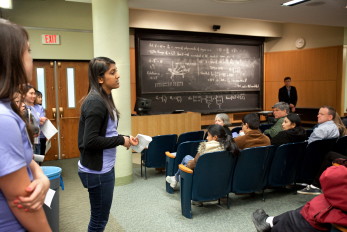COVER STORY
(Page 4 of 5)Diversity as a policy goal
Aggressive recruitment and retention strategies are making their way into college policy. Allmendinger, who oversees the Diversity Programs in Engineering (DPE) office, also is responsible for monitoring all tenure and promotion cases across the college. Throughout the process of recruiting new faculty, he notes, diversity is a unifying and overarching goal – of particular importance as the college hires the next generation of faculty through the universitywide $100 million Faculty Renewal Fund (see related story, page 22).
He is in a position to help junior faculty make the transition to success – for example, making sure they don't become overcommitted, as assistant professors so often do. "I can tell them the most important thing they can do for diversity is to get tenure," Allmendinger says.
He also chairs the college's Strategic Oversight Committee, created in 2007 to monitor the hiring process and keep search committees accountable to good recruiting practices that pay attention to diversity. According to Collins, just having an associate dean for diversity underscores the importance of the issue.
"It gives that person leverage – and that is required – to oversee the searches going on across the whole college," Collins says.

Current students answer questions during Diversity Hosting Weekend. See larger image
Gone are the days of traditional faculty searches, where a bunch of journal ads sufficed, and "you waited to see who came in," Collins says. "That is a very unlikely way to yield a rich pool of diverse candidates."
Instead, Collins says, search committees are expected to consider the word "search" in its truest sense. "They should be using their networks to find candidates out there who are outstanding, maybe at their earliest stages of development, who are not even sure they want an academic career," Collins explains. "They are not the ones who are necessarily going to immediately submit their resumes, but they are qualified potential faculty. We want an active process."
'A broad panorama of populations'
The college's efforts to increase faculty diversity work in tandem with initiatives to recruit and then provide support to a more diverse student body.
"When you look at our programs, they span from pre-college to faculty," says Sara Xayarath Hernandez, director of DPE. "We are looking at a broad panorama of populations, and we are able to leverage opportunities that allow us to intersect programs that target more than one of these populations."
Examples include DPE-run summer programs for high school students: CURIE for women and CATALYST for minorities and first-generation college students. The programs succeed because of undergraduate and graduate students, who work as program assistants, and faculty members, who run field sessions and coordinate research projects.
There's no magic formula, but departments like materials science and engineering show how emphasizing diversity in recruitment pays off. In the past seven years, the department has hired three women – Chekesha Liddell Watson, Lara Estroff and Delphine Gourdon. Robinson, a minority, was hired in 2008.
Department chair Emmanuel Giannelis credits the department, college and university all working together to provide resources and pay particular attention to creating a diverse pool.
Simple things, he observes, pay dividends. Giving every candidate serious consideration, for one. "If the candidate that you find is strong, but doesn't necessarily fit the limited area you are looking in, are you willing to shift a little bit? … How are you willing to be flexible and go with the opportunities that are presented to you?"
Departments like materials science are helped by their interdisciplinary nature, Giannelis adds. This widens the recruitment field to those who have studied chemistry, physics or mechanical engineering.
Other, more traditional engineering departments face more complex obstacles at all levels – recruiting faculty, all the way down to the undergraduate level. Among women, the problem of leakage in the "pipeline" – the number of Ph.D. candidates with potential to enter academia – is more pervasive in some disciplines. Mechanical engineering and electrical engineering, the two largest Cornell engineering departments, traditionally have had more trouble attracting women students, says Sheila Hemami, professor of electrical and computer engineering.
\<<View entire story as one page>>